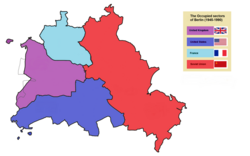Occupation of Germany
| German Reich | ||||||||||||||||
| Deutsches Reich | ||||||||||||||||
| Military occupation | ||||||||||||||||
|
||||||||||||||||
|
Post-Nazi German occupation borders and territories from 1945 to 1949.
British (green), French (blue), American (yellow) and Soviet (red) occupation zones. Saar Protectorate (orange) in the west under the control of France. Berlin is the quadripartite area shown within the red Soviet zone. Bremen consists of the two yellow American exclaves in the British sector. |
||||||||||||||||
| Capital |
|
|||||||||||||||
| Political structure | Military occupation | |||||||||||||||
| Governors (1945) | ||||||||||||||||
| • | British zone | F. Mar. Montgomery | ||||||||||||||
| • | French zone | Gen. Lattre de Tassigny | ||||||||||||||
| • | US zone | Gen. Eisenhower | ||||||||||||||
| • | Soviet zone | Marshal G. K. Zhukov | ||||||||||||||
| Historical era | Cold War | |||||||||||||||
| • | Surrender | 8 May 1945 | ||||||||||||||
| • | Allied Control Council | 5 July 1945 | ||||||||||||||
| • | Saar Protectoratea | 15 December 1947 | ||||||||||||||
| • | Federal Republic of Germany | 23 May 1949 | ||||||||||||||
| • | German Democratic Republicb | 7 October 1949 | ||||||||||||||
| • | Final Settlementc | 12 September 1990 | ||||||||||||||
| Currency |
|
|||||||||||||||
|
||||||||||||||||
| a. | Joined the Federal Republic of Germany (West Germany) on 1 January 1957. | |||||||||||||||
| b. | Reunited Germany by joining the Federal Republic of Germany on 3 October 1990. | |||||||||||||||
| c. | German reunification took place on 3 October 1990. | |||||||||||||||
| d. | The western Allied zones of Germany and the western sectors of Berlin. | |||||||||||||||
| e. | The Soviet zone of Germany and sector of Berlin. | |||||||||||||||
 The four sectors of the Allied occupation of Berlin and exclaves. |
||||||||||||||||
Upon the defeat of Nazi Germany in World War II, the victorious Allied powers asserted their authority over all territory of the German Reich which lay west of the Oder–Neisse line, having formally abolished the government of Adolf Hitler (see 1945 Berlin Declaration). The four powers divided Germany into four occupation zones for administrative purposes, into what is collectively known now as Allied-occupied Germany (German: Alliierten-besetztes Deutschland). This division was ratified at the Potsdam Conference (17 July to 2 August 1945). In Autumn 1944 the United States, United Kingdom, and Soviet Union had agreed on the zones by the . The powers approved the eventual detachment of much of the German eastern territories, lying east of the Oder-Neisse line, from Germany; the contemplated Final German Peace Treaty would determine the Polish-German and USSR-Polish border lines for the former German territories. The Final German Peace Treaty would result in the "shifting westward" of Poland's borders back to approximately as they were before 1722. In the closing weeks of fighting in Europe, United States forces had pushed beyond the agreed boundaries for the future zones of occupation, in some places by as much as 320 kilometres (200 mi). The so-called line of contact between Soviet and American forces at the end of hostilities, mostly lying eastward of the July 1945-established inner German border was temporary. After two months in which they had held areas that had been assigned to the Soviet zone, U.S. forces withdrew in the first days of July 1945. Some have concluded that this was a crucial move that persuaded the Soviet Union to allow American, British, and French forces into their designated sectors in Berlin, which occurred at roughly the same time (July 1945), although the need for intelligence gathering (see Operation Paperclip) may also have been a factor.
...
Wikipedia


